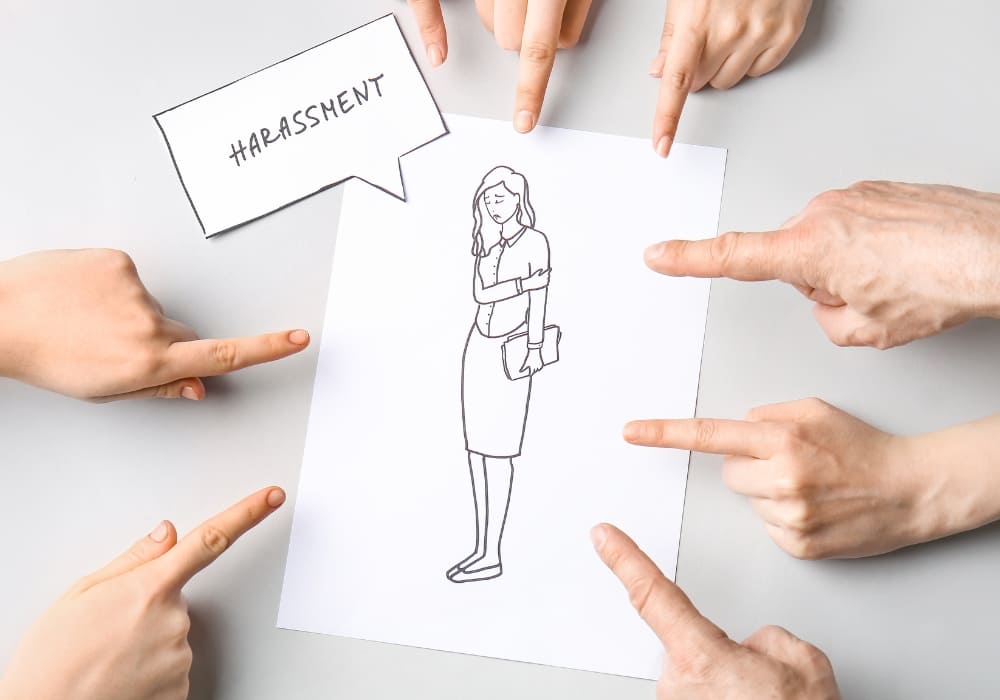Sexual harassment in the workplace isn’t always as obvious as a creepy boss whispering inappropriate things in the break room. Sometimes, it’s subtle–hidden behind “jokes,” “friendly touches,” or “innocent” requests that make you squirm. But here’s the truth: if it feels wrong, it probably is. And the more we learn to spot the red flags, the faster we can put an end to it. So, let’s dive into the warning signs and, more importantly, how to shut them down before they escalate.
Red Flags: When “Normal” Crosses the Line
- The Serial “Accidental” Toucher: You know that colleague who always seems to brush against you, stand too close, or rest their hand on your shoulder a little too long? Yeah, that’s not an accident. Respect for personal space should be a given, not a requested.
- The Master of “Just Joking”: If someone’s “jokes” always seem to involve sexual innuendos, inappropriate comments about your body, or “harmless” flirting that makes you uncomfortable–trust your gut. That’s not humour; that’s harassment. If it wouldn’t be funny in a court of law, it’s sure as hell not funny at work either.
- The “Work Wife” or “Work Husband” Gambit: If a coworker insists on treating you like their “office spouse” and makes it weird–like forcing intimacy, calling you pet names, or acting possessive–it’s a red flag. Relationships at work should be professional, not a romantic subplot.
- The Favor-For-Favor Scheme: If promotions, raises, or even basic job security seem to be tied to “spending time” with someone in power, that’s textbook quid pro quo harassment. No exceptions. If your paycheque or promotion depends on saying “yes” to something that makes you uncomfortable, that’s not a job opportunity–it’s coercion.
- The Unwanted Digital Creeper: Late-night messages, suggestive emojis, inappropriate comments on your social media pictures–when your colleague starts acting like they belong in your DMs instead of a boardroom, that’s a problem. Your online space is still your space.
- The One Who Doesn’t Understand “No”: If someone keeps asking you out, even after you’ve made it clear you’re not interested, that’s not persistence–it’s pressure. No means no, even in the workplace.
- The Meeting Room Trapper: Ever had a boss or coworker corner you in an office, close the door, and make things awkward? That’s intimidation, and it’s meant to make you feel powerless. If you ever feel trapped, get out and report it.
Real Solutions: How to Prevent Workplace Harassment
1. Set Clear Boundaries
If something makes you uncomfortable, say it loud and clear. “I don’t like that” or “That’s not appropriate” is a simple yet powerful way to make it known that you won’t tolerate misconduct. If someone keeps pushing, escalate the issue.
2. Speak Up & Document Everything
If a situation escalates, keep records–dates, times, places, and details of inappropriate behaviour. The more concrete your evidence, the stronger your case. Screenshots, emails, and witness testimonies can be your best allies.
3. Employers, Create a Safe Reporting System
Companies should have clear, confidential ways for employees to report harassment. No one should fear retaliation for standing up for themselves. Anonymous reporting channels can encourage victims to come forward without fear.
4. Know Your Rights (And Use Them!)
In Ghana, the Labour Act 2003 (Act 651) protects employees from workplace harassment. You don’t have to “just deal with it.” Report it to HR, the National Labour Commission, or even take legal action. The law is on your side.
5. Train, Educate, and Reinforce
Workplaces should regularly conduct training sessions on sexual harassment awareness and prevention. The more informed employees are, the less likely they are to either commit or tolerate harassment.
6. Lead by Example
If you see something, say something. Being a silent bystander only enables the problem. Call out inappropriate behaviour when you see it. Create a workplace culture where respect isn’t just a policy–it’s the norm.
Time to Take Action
Sexual harassment isn’t “just part of office culture,” and it’s certainly not a joke. It’s a serious issue that affects both men and women, wrecking careers, mental health, and workplace morale. The good news? By spotting the red flags and taking real action, we can make our workplaces safer, stronger, and way more professional.
Got a story or thoughts to share? Drop them in the comments–let’s keep this conversation going!



